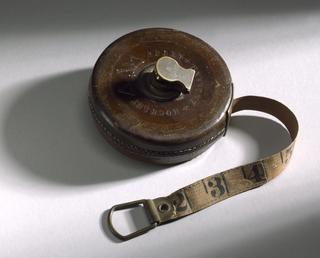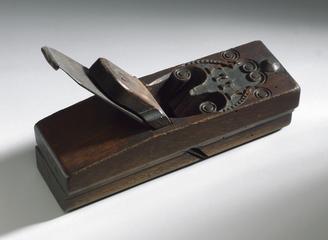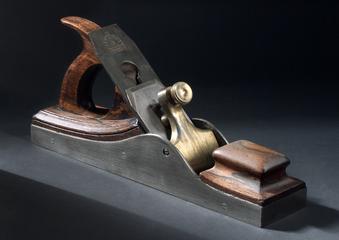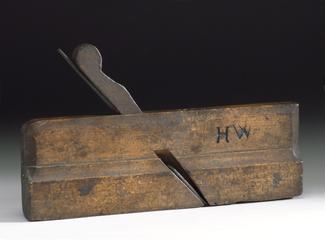
Parkers automatic screw making machine
- Made:
- circa 1880 in Leeds
- maker:
- Greenwood and Batley Limited
Parkers automatic screw making machine, size A, by Greenwood and Batley Ltd.
This lathe, patented by C. W. Parker in 1879, for automatically producing screws, was made by Greenwood and Batley, Ltd. The screw blanks are turned from a metal rod, which is fed in through the fast headstock against stationary tools; these tools are then withdrawn and the screwing die advanced, and retired after cutting the thread; a parting tool then cuts off the screw. The heads are finished and nicked in a separate machine, but, originally, the machine was designed to perform these operations also.
At one end of the bed is a fast headstock with a speed cone and hollow mandrel; at the other end is a headstock carrying the threading spindle and its mechanism. A shaft runs through the bed and upon it the cams giving the requisite motion are mounted. The front end of the speed cone is fitted with a spring chuck that guides the rod which is being fed. A diaphragm is fitted near the rear end, to which the tail of the mandrel is fixed, and inside the hollow cone is a roller feeding device, which is arranged to accommodate rods of different diameters. The rollers are driven by skew-toothed wheels and spur gearing, from the end of the main spindle, through a toothed clutch, in the same direction as, but at a slightly less speed than, the spindle. When the rod has advanced to the correct distance, the clutch is thrown out of gear by a lever and cam; the spindle and sleeve then rotate at the same speed and the feed stops. The turning tools are mounted on a cross slide at the front and the parting tool is mounted on a slide at the back, and is connected with the front slide by an adjustable rod so that one bellcrank lever, actuated by a cam and weight, moves both slides.
The screwing gear consists of a hollow sliding spindle having the die fitted to its nose; this is driven from the main spindle in the same direction as, but at a higher speed than, the screw blank. The spindle is advanced towards the blank and is left free when the die has commenced cutting; when the thread is completed, the spindle is released, its rotation is stopped, and the die is permitted to unscrew itself. The cam shaft is driven from the main spindle through a countershaft, spur and bevel gearing, and its rotation is stopped and restarted by automatically engaging and disengaging the work and wheel.
Lubrication is supplied to the turning and screwing tools by a rotary pump, to the latter through the hollow spindle and a telescopic pipe. The machine will make screws from 0-125 in to 0-312 inches diameter, with heads of any form; it will turn out from 80 to 150 screws per hour of 25 in diameter according to length. The main spindle runs at from 300 to 500 rpm."
Details
- Category:
- Hand and Machine Tools
- Object Number:
- 1908-22
- Materials:
- steel (metal), cast iron and gunmetal
- Measurements:
-
overall: 1170 mm x 1770 mm x 660 mm, 579.2472 kg
- type:
- screw making machine
- credit:
- Boorer, J.J.




